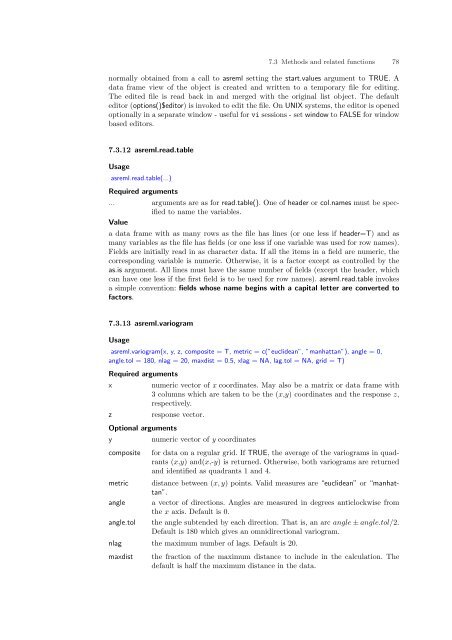ASReml-S reference manual - VSN International
ASReml-S reference manual - VSN International
ASReml-S reference manual - VSN International
- No tags were found...
You also want an ePaper? Increase the reach of your titles
YUMPU automatically turns print PDFs into web optimized ePapers that Google loves.
7.3 Methods and related functions 78normally obtained from a call to asreml setting the start.values argument to TRUE. Adata frame view of the object is created and written to a temporary file for editing.The edited file is read back in and merged with the original list object. The defaulteditor (options()$editor) is invoked to edit the file. On UNIX systems, the editor is openedoptionally in a separate window - useful for vi sessions - set window to FALSE for windowbased editors.7.3.12 asreml.read.tableUsageasreml.read.table(...)Required arguments... arguments are as for read.table(). One of header or col.names must be specifiedto name the variables.Valuea data frame with as many rows as the file has lines (or one less if header=T) and asmany variables as the file has fields (or one less if one variable was used for row names).Fields are initially read in as character data. If all the items in a field are numeric, thecorresponding variable is numeric. Otherwise, it is a factor except as controlled by theas.is argument. All lines must have the same number of fields (except the header, whichcan have one less if the first field is to be used for row names). asreml.read.table invokesa simple convention: fields whose name begins with a capital letter are converted tofactors.7.3.13 asreml.variogramUsageasreml.variogram(x, y, z, composite = T, metric = c(”euclidean”, ”manhattan”), angle = 0,angle.tol = 180, nlag = 20, maxdist = 0.5, xlag = NA, lag.tol = NA, grid = T)Required argumentsxzOptional argumentsycompositemetricangleangle.tolnumeric vector of x coordinates. May also be a matrix or data frame with3 columns which are taken to be the (x,y) coordinates and the response z,respectively.response vector.numeric vector of y coordinatesfor data on a regular grid. If TRUE, the average of the variograms in quadrants(x,y) and(x,-y) is returned. Otherwise, both variograms are returnedand identified as quadrants 1 and 4.distance between (x, y) points. Valid measures are “euclidean” or “manhattan”.a vector of directions. Angles are measured in degrees anticlockwise fromthe x axis. Default is 0.the angle subtended by each direction. That is, an arc angle ± angle.tol/2.Default is 180 which gives an omnidirectional variogram.nlag the maximum number of lags. Default is 20.maxdistthe fraction of the maximum distance to include in the calculation. Thedefault is half the maximum distance in the data.
















